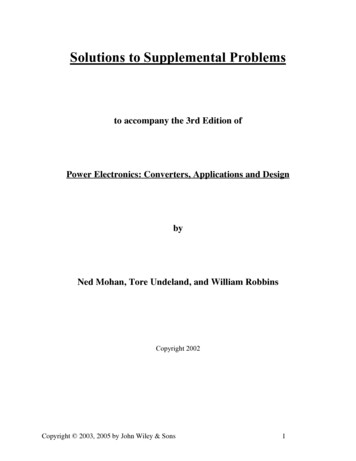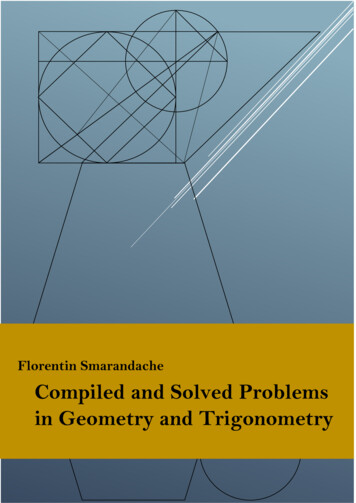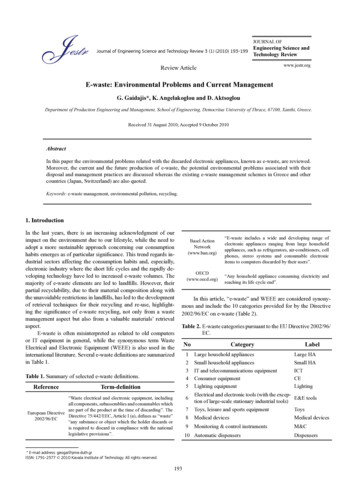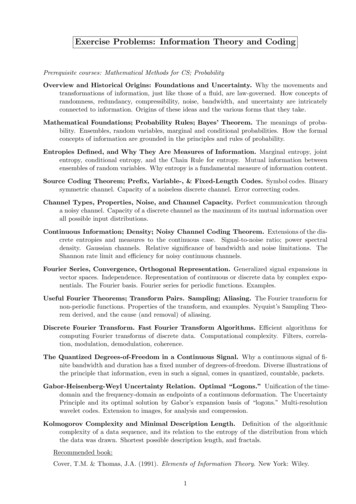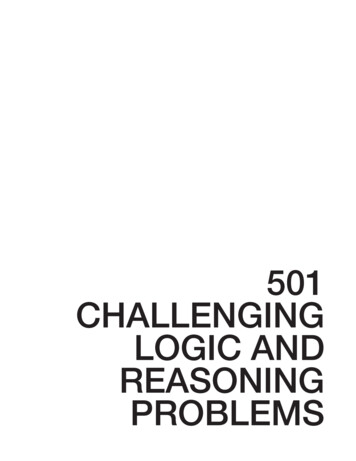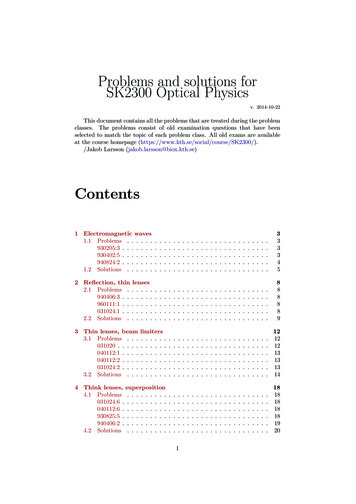
Transcription
Problems and solutions forSK2300 Optical Physicsv. 2014-10-22This document contains all the problems that are treated during the problemclasses. The problems consist of old examination questions that have beenselected to match the topic of each problem class. All old exams are availableat the course homepage (https://www.kth.se/social/course/SK2300/)./Jakob Larsson (jakob.larsson@biox.kth.se)Contents1 Electromagnetic waves1.1 Problems . . . . . .930205:3 . . . . . . .930402:5 . . . . . . .940824:2 . . . . . . .1.2 Solutions . . . . . .3333452 Reflection, thin lenses2.1 Problems . . . . . .940406:3 . . . . . . .960111:1 . . . . . . .031024:1 . . . . . . .2.2 Solutions . . . . . .888889limiters. . . . . . . . . . . . . . . . . . . . . . . . . . . . . . .121212131313144 Think lenses, superposition4.1 Problems . . . . . . . . .031024:6 . . . . . . . . . .040112:6 . . . . . . . . . .930825:5 . . . . . . . . . .940406:2 . . . . . . . . . .4.2 Solutions . . . . . . . . .181818181819203 Thin lenses, beam3.1 Problems . . .031020 . . . . .040112:1 . . . .040112:2 . . . .031024:2 . . . .3.2 Solutions . . .1
Problems and solutionsCONTENTS5 Polarization, birefringence5.1 Problems . . . . . . . . .031020:5 . . . . . . . . . .040112:4 . . . . . . . . . .950419:3 . . . . . . . . . .950301:1 . . . . . . . . . .5.2 Solutions . . . . . . . . .232323232324256 Interference6.1 Problems031020:6 .031024:4 .930402:4 .030107:3 .6.2 Solutions.292929292929307 Diffraction7.1 Problems031024:3 .031024:5 .040112:3 .040112:5 .940824:4 .930825:4 .7.2 Solutions.3333333333333434352
Session 1Electromagnetic waves1.1Problems930205:3The circles in bold in the figure below is meant to illustrate a cross section of abeam of light. The left one illustrates a circularly polarized wave. In this casethe electric field vector, E, turns around with constant amplitude. The questionis whether the electric field vector can look like the ones in the right circle.930402:5Light is reflected back and forth between two lossless mirrors like in the figurebelow. The incoming light, at A, is a plane wave with the electric field vectorin the plane of the paper. The incidence angle of the light is 45 . The mainpropagation direction of the light wave is in the z-direction. Find the ratiobetween the longitudinal and the transverse electric field component! What isthe phase speed in the z-direction?LightinMirrorAMirror3yz
Problems and solutionsSession 1. Electromagnetic waves940824:2A poor student in physics is performing calculations on a problem where thewave equation describing the propagation of light is involved. He/She ends upwith a solution where the D- and E-field is not in phase with each other, buthas a small phase difference ( δ 1 ). Confusion arises in his/her head whichis why we want you to explain what phenomenon that can give rise to this!Some equations would be helpful to make him/her understand.4
Problems and solutions1.2Session 1. Electromagnetic wavesSolutions930205:3The propagation direction (k) is perpendicular to the board. Also, we knowthat E, B and k are all perpendicular. The only possible configuration for thecase in the right circle is thenBEkBkEEkBkEBHowever, from Maxwell’s equations we know that ·B 0{B · dS 0(no magnetic monopoles)(no net magnetic flux through a closed surface)A cylindrical surface around the beam would have a net flux The E-field cannot look like the one in the right circle.930402:5Lets start with the expression describing an arbitrary plane wave,}{E(r, t) Re E0 ei(k·r ωt)where E0 [Ex , Ey , Ez ], r [x, y, z] and k [kx , ky , kz ]. It it often easierto perform the calculations with complex waves and then take the real part ofthe end result to find the physical real wave. The total field Etot between themirrors is the sum of two fields E and E , where the second is a reflectionof the first. Since the incident light is p-polarized the reflected wave will not5
Problems and solutionsSession 1. Electromagnetic wavesundergo a phase shift (according to the Fresnel equations). The problem is in2D so we will only consider the y and z components of the electric field.Etot E E [Ey , Ez ] ei(ky y kz z ωt [Ey , Ez ] ei( ky y kz z ωt{}kE0 ky kz , Ey Ez 22 E0e2 ky/ 2 ky/ 2ky/ 2 ky/ 2 e, e e e} {z} {z} 2 cos(ky/ 2) 2i sin(ky/ 2) {z } {z } i(kz/ 2 ωy){zeiφ θ θ2E0 (cos φ i sin φ)[cos θ, i sin θ]Now we find the physical field by taking the real part of this result, Etot 2E0 [cos φ cos θ, sin φ sin θ]The ratio between the z and the y component Etot is then, Etot,z tan φ tan θ tan(kz/ 2 ωt) tan(ky/ 2)Etot,yThe phase velocity in the z direction is found by calculating how fast a pointwith constant phase is moving, φ kz/ 2 ωt C z (C ωt)2k zω 2 c 2 tkThis does not mean that information can be transfered faster than the speed oflight! The wave fronts are just positions in space where the phase is constant.These positions can move with infinite velocity. Modulations of the initial wavewill propagate like a short light pulse would.940824:2 Eout-Ep -First we have to know how the outer electric field Eout , the so called displacement field D ε0 Eout , and the electric field inside the dielectric material E6
Problems and solutionsSession 1. Electromagnetic wavesare related. If an external electric field is applied to a dielectric (not conducting) material the material will be polarized, resulting in a polarization P. Therelation is then,E PD ε0ε0 D ε0 E PIf P 0, as in vacuum, E and D are in phase. If they are out of phasethis must be due to the polarization of the material. This depends on theelectrical susceptibility χe of the material, which describes how easy the materialis polarized P ε0 χe E.D ε0 E ε0 χe E ε0 (1 χe ) E εE {z }εrwhere εr is the relative permittivity (dielectric constant) of the material. If εris real there will be no phase difference between E and D, but if εr is complex(or negative) εr A eiφ it will introduce a phase difference of φ. Now, what isthe physical meaning of a complex εr ? ε is related to the speed of propagationc, which is related to the index of refraction n. εµ c0n εr µr {µr 1 for most optical materials} εrcε0 µ0So a complex εr results in a complex index of refraction n α iβ. The realpart α of the complex index of refraction is related to the propagation speedand the imaginary part is related to absorption or amplification.{}2π2πnE E0 ei(kz ωt) k k0 nλλ0 E0 ei(k0 z(α iβ) ωt) E0 e k0 βz ·ei(k0 αz ωt) {z }amplitudeThe intensity I(z) will then decrease, or increase, exponentially in the followingway,I(z) E 2 E · E E0 2 e 2k0 βz7
Session 2Reflection, thin lenses2.1Problems940406:3A police standing beside the road that wants to study the use of seatbelts incars has good use for a pair of polarizing sunglasses. How much is the reflectionfrom the windscreen reduced when he wears them, if he is positioned accordingto the figure below?Car25 Police960111:1Assume that we have a 45-45-90-degree prism where a parallel laser beam isincident against one of the cathetus at normal incidence. The refractive indexis 1.54 and the prism is surrounded by air. Is it possible to design an AR-coating(anti reflection) such that the hypotenuse has a transmittance higher than 10%?031024:1Modern cameras unfortunately often have a fixed objective that can not bechanged. However, one can change the focal length of the system by attachingan afocal lens combination in front of the camera objective. The system focallength is thereby changed by a factor equal to the telescope magnification ofthe lens combination that was attached. Show this by using a ray diagram andconformal triangles! Make a nice figure that is easy to understand!8
Problems and solutions2.2Session 2. Reflection, thin lensesSolutions940406:3Polarizing sunglasses works by absorbing one polarization and transmitting theother. Sunlight is unpolarized but the reflection will be partly polarized so itcan be reduced by the glasses.The reflectance of the two polarizations are given by[[]2]2sin (θi θt )tan (θi θt )R , R sin (θi θt )tan (θi θt )Without the glasses the intensity will be11I0 R I0 R .22With glasses one polarization is blocked,Iw/o 1I0 R , R or R 2so the glasses will reduce the intensity from the reflection by a factor ofIwith Iw/oR R .IwithR We now have to find θi and θt . Assume the angle of the windscreen to be 45 :a)zyxsunlight nyb)zx45 α 25 rThe normal to the windscreen is then1n̂ cos 45 x̂ sin 45 ẑ (x̂ ẑ),2and the direction of the reflected light isr̂ cos αx̂ sin αŷThe angle between them is the reflection angle 1θr θi cos 1(n̂ · r̂) cos(cos α 2) 50 We can now calculate the transmission angle from Snell’s law. Assume that therefractive index of the windscreen is n1 1.5.n0 sin θi n1 sin θt()n0 1 θt sinsin θi 31 n19
Problems and solutionsSession 2. Reflection, thin lensesThis gives us R 0.11 and R 0.003.If R is blocked we get a reduction by a factor ofR R 0.11 0.003 37,R 0.003and if R is blockedR R 0.11 0.003 1.03. R 0.003In order to completely block one of the polarizations the police has to tilt his/herhead tan 1 (sin α) 23 to the right.960111:1a)b)n 1.54n0 1θin 1.54n1θtn0 1θiθθ11θtStart by looking at the case without any coating (figure a). Snell’s law gives usn0 sin θt n sin θi 1.09 1 Total internal reflection!If we add one layer with a refractive index of n1 (figure b), we get{n sin θi n1 sin θ1First surfacen1 sin θ1 n0 sin θt Second surface n0 sin θt n sin θi 1.09Conclusion: We get total internal reflection independently of coating so no lightcan be transmitted. It is therefore not possible to design AR-coating so thatthe hypotenuse would have T 10%.10
Problems and solutionsSession 2. Reflection, thin lenses031024:1Start by finding an expression for Mt .Parallel beams entering an afocal system will exit the system in parallel:f1f2wα-βyf1-w’f2From the figure we can see that the angular magnification is given byMt β y/f2f1 .αy/f1f2Using similar triangles we see that this is equal to the ratio of the beam widthbefore and after the system.w w′wf1 ′ Mt .f1f2wf2The combined system with both the telescope and camera objective will thenlook likeAfocal systemMtwObjectiveffront focalplanew’ffsystsystem back objective backprincipal plane principal planeAgain, using similar triangles we see thatfsystw ′ Mtfwwhich was to be demonstrated.11
Session 3Thin lenses, beam limiters3.1Problems031020Task 1-3 treat the same problem which is described below:You have a laser beam which can be treated as circular, i.e. you don’t haveconsider a Gaussian profile, and you want to build a telescope that can beadjusted in such a way that the magnification can be varied between a valuesmaller than 1 and one which is bigger than 1. You have the following lenspackage at your disposal.a. a f -20 mm lens with a diameter of 10 mmb. a f 50 mm lens with a diameter of 20 mmThe distance between the two lenses, d, can be varied from 35 mm to 50 mm.Another lens, with f -100 mm and a diameter of 40 mm, is placed at a distance(for you to calculate) after the lens system.The laser beam is parallel (not divergent or convergent) both when entering andexiting the telescope.031020:1-2Construct the system, i.e. draw a figure with all distances marked for the casewhere d 40 mm.Between which values can the magnification be varied?031020:3Assume that the beam has a radius bigger than 4 mm, in which case diffractionwill occur. What angular spread does this give rise to? Assume d to be 40 mmand that λ 514 nm.12
Problems and solutionsSession 3. Thin lenses, beam limiters040112:1An ophthalmologic biomicroscope is used for looking into the human eye. Ithas a special illumination system, the details of which are not given here. It hasan objective with a focal length of 50 mm and an eyepiece with 20 mm focallength. The distance between the back principal plane of the objective and thefront principal plane of the eyepiece is 220 mm.The objective has a front vertex focal length of 90 mm.How far into the eye is it possible to see if the eye is modeled by a sphere witha radius of curvature of 5 mm at cornea and a refractive index of 1.3306?The distance from cornea to retina is such that a sharp image of a distantobject is obtained on the retina.040112:2When the previous task is solved you will have found that it is not possible tosee the retina since it is approximately 20 mm from cornea.One way to observe the retina is to use a strong positive lens (40 D) to imagethe retina into a real image which is in turned viewed by the doctor who at thesame time images the pupil of the patients eye onto his/her own pupil using thesame 40 D lens. The patient’s eye is relaxed, i.e. focused at distant objects.How lar
Problems and solutions Session 1. Electromagnetic waves 1.2 Solutions 930205:3 The propagation direction (k) is perpendicular to the board. Also, we know that E, B and k are all perpendicular. The only possible configuration for the case in the right circle is then B B B B E E E E k k k However, from Maxwell’s equations we know that B .File Size: 1MBPage Count: 39
